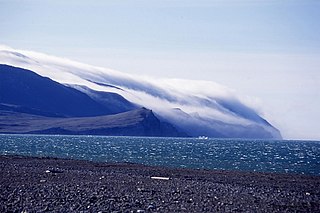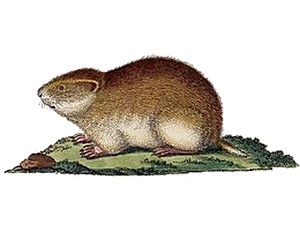
The Arvicolinae are a subfamily of rodents that includes the voles, lemmings, and muskrats. They are most closely related to the other subfamilies in the Cricetidae. Some authorities place the subfamily Arvicolinae in the family Muridae along with all other members of the superfamily Muroidea. Some refer to the subfamily as the Microtinae or rank the taxon as a full family, the Arvicolidae.

The Norway lemming, also Norwegian lemming is a common species of lemming found in northern Fennoscandia. It is the only vertebrate species endemic to the region. The Norway lemming dwells in tundra and fells, and prefers to live near water. Adults feed primarily on sedges, grasses and moss. They are active at both day and night, alternating naps with periods of activity.

The northern collared lemming or Nearctic collared lemming, sometimes called the Peary Land collared lemming in Canada, is a small North American lemming. At one time, it was considered to be a subspecies of the Arctic lemming. Some sources believe several other species of collared lemmings found in North America are actually subspecies of D. groenlandicus.
The Amur lemming is a species of lemmings found near the Amur River in Siberia.

The genus Lemmus contains several species of lemming sometimes referred to as the true lemmings. They are distributed throughout the Holarctic, particularly in the Palearctic.

The North American brown lemming is a small North American lemming. Originally called the Siberian brown lemming they were later formed into two distinct species.

The grey red-backed vole or the grey-sided vole is a species of vole. An adult grey red-backed vole weighs 20-50 grams. This species ranges across northern Eurasia, including northern China, the northern Korean Peninsula, and the islands of Sakhalin and Hokkaidō. It is larger and longer-legged than the northern red-backed vole, which covers a similar range and it is also sympatric with the Norwegian lemming.

Wrangel Island is an island in the Arctic Ocean, between the Chukchi Sea and East Siberian Sea. Wrangel Island lies astride the 180° meridian. The International Date Line is displaced eastwards at this latitude to avoid the island as well as the Chukchi Peninsula on the Russian mainland. The closest land to Wrangel Island is the tiny and rocky Herald Island located 60 km (37 mi) to the east. Wrangel Island may have been the last place on earth where mammoths survived.

Dicrostonyx is a genus of rodent in the family Cricetidae. It contains the collared lemmings. They are the only North American rodents that turn completely white in winter. It contains the following species:

The Arctic lemming is a species of rodents in the family Cricetidae.
The Unalaska collared lemming is a species of rodents in the family Cricetidae. This species is found on two islands, Umnak and Unalaska, in the Aleutian Archipelago of Alaska in the United States. Its natural habitat is tundra.
The Wrangel lemming is a species of rodent in the family Cricetidae. It is found only on Wrangel Island in the Arctic Ocean off the coast of eastern Russia. Its natural habitat is tundra, and it is threatened by habitat loss.
Przewalski's steppe lemming is a species of rodents in the family Cricetidae. It is found in China and Mongolia.

The Siberian brown lemming is a species of rodents in the family Cricetidae found in the Russian Federation. It does not hibernate during winter; it lives in burrows. It is prey to several animals, including the snowy owl and the Arctic fox. The lemmings are known for their high-amplitude, large-scale fluctuations of population sizes.

Portenko's shrew is a species of mammal in the family Soricidae that is endemic to Russia.

A lemming is a small rodent, usually found in or near the Arctic in tundra biomes. Lemmings make up the subfamily Arvicolinae together with voles and muskrats, which form part of the superfamily Muroidea, which also includes rats, mice, hamsters, and gerbils.
Topografov virus is an enveloped, negative-sense RNA virus species of the genus orthohantavirus in the Bunyavirales order. It is the first hantavirus to be isolated from Siberian lemmings found near the Topografov River in the Taymyr Peninsula, Siberia.










